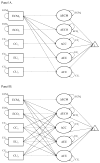Developmental dynamics of emotion and cognition processes in preschoolers
- PMID: 22925076
- PMCID: PMC3511641
- DOI: 10.1111/j.1467-8624.2012.01841.x
Developmental dynamics of emotion and cognition processes in preschoolers
Abstract
Dynamic relations during the preschool years across processes of control and understanding in the domains of emotion and cognition were examined. Participants were 263 children (42% non-White) and their mothers who were seen first when the children were 3 years old and again when they were 4. Results indicated dynamic dependence among the processes studied. Specifically, change in cognitive processes of control and understanding were dependent upon initial levels of the other processes. Changes in emotion control and understanding were not predicted by earlier performance in the other processes. Findings are discussed with regard to the constructs of control and understanding and the developmental interrelations among emotion and cognitive processes.
© 2012 The Authors. Child Development © 2012 Society for Research in Child Development, Inc.
Figures



Similar articles
-
Children's Facial Emotion Recognition Skills: Longitudinal Associations With Lateralization for Emotion Processing.Child Dev. 2020 Mar;91(2):366-381. doi: 10.1111/cdev.13188. Epub 2018 Dec 6. Child Dev. 2020. PMID: 30521072
-
Thinking or feeling? An exploratory study of maternal scaffolding, child mental state talk, and emotion understanding in language-impaired and typically developing school-aged children.Br J Educ Psychol. 2018 Jun;88(2):261-283. doi: 10.1111/bjep.12194. Epub 2017 Oct 6. Br J Educ Psychol. 2018. PMID: 28984350
-
Linking children's neuropsychological processing of emotion with their knowledge of emotion expression regulation.Laterality. 2007 Sep;12(5):381-96. doi: 10.1080/13576500701381630. Laterality. 2007. PMID: 17712711
-
Does emotion influence visual perception? Depends on how you look at it.Cogn Emot. 2019 Feb;33(1):77-84. doi: 10.1080/02699931.2018.1561424. Epub 2019 Jan 12. Cogn Emot. 2019. PMID: 30636535 Review.
-
The role of the frontal lobes in the regulation of cognitive development.Brain Cogn. 1992 Sep;20(1):51-73. doi: 10.1016/0278-2626(92)90061-p. Brain Cogn. 1992. PMID: 1389122 Review.
Cited by
-
Larger increase in trait negative affect is associated with greater future cognitive decline and vice versa across 23 years.Depress Anxiety. 2021 Feb;38(2):146-160. doi: 10.1002/da.23093. Epub 2020 Aug 25. Depress Anxiety. 2021. PMID: 32840954 Free PMC article.
-
Early Emotion Knowledge and Later Academic Achievement Among Children of Color in Historically Disinvested Neighborhoods.Child Dev. 2020 Nov;91(6):e1249-e1266. doi: 10.1111/cdev.13432. Epub 2020 Aug 31. Child Dev. 2020. PMID: 32865229 Free PMC article. Clinical Trial.
-
Intervention response among preschoolers with ADHD: The role of emotion understanding.J Sch Psychol. 2021 Feb;84:19-31. doi: 10.1016/j.jsp.2020.11.001. Epub 2020 Dec 5. J Sch Psychol. 2021. PMID: 33581768 Free PMC article.
-
Relations between executive function and emotionality in preschoolers: Exploring a transitive cognition-emotion linkage.Front Psychol. 2014 May 27;5:487. doi: 10.3389/fpsyg.2014.00487. eCollection 2014. Front Psychol. 2014. PMID: 24904500 Free PMC article.
-
Emotion Knowledge and Attention Problems in Young Children: a Cross-Lagged Panel Study on the Direction of Effects.J Abnorm Child Psychol. 2017 Jan;45(1):45-56. doi: 10.1007/s10802-016-0157-5. J Abnorm Child Psychol. 2017. PMID: 27126685
References
-
- Astington JW, Gopnik A. Knowing you’ve changed your mind: Children’s understanding of representational change. In: Astington JW, Harris PL, editors. Developing theories of mind. New York: Cambridge University Press; 1988. pp. 193–206.
-
- Barrett KC, Campos JJ. Perspectives on emotional development II: A functionalist approach to emotions. In: Osofsky JD, editor. Handbook of infant development. 2. New York: Wiley; 1987. pp. 555–578.
-
- Bartsch K, Wellman HM. Children talk about the mind. New York: Oxford University Press; 1995. - DOI
-
- Bentler PM. Comparative fit indices in structural equation models. Psychological Bulletin. 1990;107:238–246. apa.org/psycinfo/1990-13755-001. - PubMed

